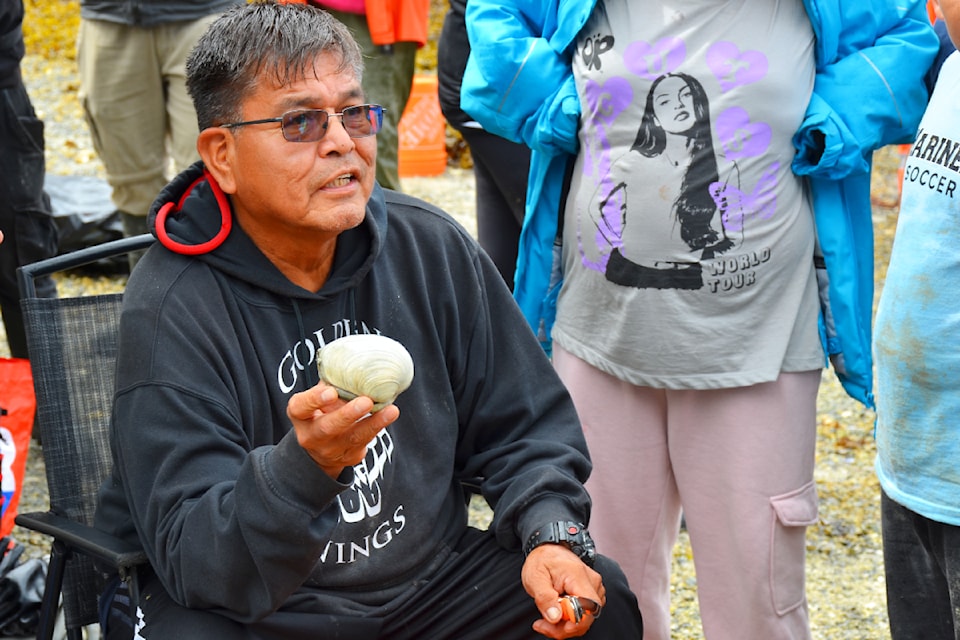On a calm August morning, cheerful voices, friendly banter and the sound of rock clunking on rock echoes through the mist and evergreen-drenched hillsides of a beach off the coast of central Vancouver Island – much like they have for thousands of years.
The sounds come from a community effort underway to restore a loxiwe or clam garden which is an ancient and sophisticated form of mariculture that increases the productivity of clam beds. For thousands of years up and down the northwest coast of North America, Indigenous people tended these gardens which involve building rock walls in suitable tidal areas and creating terraces. Rocks are then cleared out of the terraces and prime clam habitat is created. Like all gardening, it provides a sustainable and predictable food source for communities.
The practice of clam gardening goes back thousands of years. In the clam garden being restored east of Campbell River during the spring and summer of 2024, the archaeological evidence indicates it has been in use for nearly 4,000 years.
The practice was interrupted by colonization but a resurgent interest in clam gardens from the archaeological community has been accompanied by a resurgence of cultural knowledge as well as the practicality of restoring a traditional and productive food source.
In May 2024, more than 60 community members, knowledge holders, Guardians and other experts from We Wai Kai, Wei Wai Kum and K'omoks First Nations and invited advisers and guests worked for two days on the restoration of a loxiwe in the heart of Laich-Kwil-Tach territory that was identified as a key site for restoration (the precise location is being withheld). The project was supported by Nanwakolas Council with funding from Lenfest Ocean Program and the Marine Planning Partnership.
A second work session was held over three days in August 2024 and was conducted in a spirit of community with many young people participating in the work being lead by Wei Wai Kum archaeologist Christine Roberts. The bulk of the heavy lifting being done by Indigenous Guardians.
During that session, Roberts could be seen standing in a largely cleared-out terrace at the top of a beach that stretches between two islands and working the sand with a four-tined rake. She's breaking up the stone and shell debris-laced sand to allow the clams to move and grow more easily. The sand can get like cement, Roberts says, so she's turning it over just like soil in a vegetable garden so the clams can move around better. She discussed the project at hand.
"So, we're taking a look at our clam gardens and restoring them, removing the rocks, building the lower wall and just getting the rocks out of the way so the clams can start producing better," Roberts says.
The more you dig, the more clams you get, she says.
The loxiwe were integrally tied to the people and the land they were on, contributing to food security and resilience in the face of challenges like climate change.
"Clams have been here forever," Roberts says. "It's been a lot hotter and a lot colder and they've survived. I think that's pretty cool. So, hopefully, they'll always be here, right?"
The loxiwe sites were crucibles of cultural vibrancy, intergenerational knowledge-sharing and community connection. Even in modern society, clam digging is known as a social recreational activity.
Village sites were usually built next to loxiwe and communities conducted their daily and seasonal business alongside.
And while archaeologists have unveiled the expansive presence of loxiwe up and down the west coast over the last 20 years or so, they are not historical sites. They are living cultural locations that are being revived, reconnecting Nations to a long relationship with the sites that was disrupted by colonization.
"All we're doing is continuing what they did," Roberts says. "You could say we are in an arch(aeological) site but we're restoring it, based on our traditional knowledge."
There is a learning process accompanying that.
"We're just learning as we go too," Roberts says.
Archaeologist Nicole Smith participated in the August work session. She is a loxiwe project advisory committee member who has worked with Roberts and others.
First Nations have been building clam gardens up and down the coast from Alaska down to Washington State for at least 4,000 years and continuously up until the present day, she says. The garden being worked in August was one of more than 80 known in the immediate area.
Carbon dating of living material associated with excavating the base of the one of the loxiwe's walls has set a date of 3,900 years, Smith says.
The practice of working the clam gardens dropped off due to colonization and population decline. But that is being reversed and a resurgence is underway.
"Of course, there's lots of elders and communities who remember working these places and learned about how to care for them and so on," Smith says.
Following the restoration work, two workshops will be held in October with community members to discuss the process and knowledge shared and gained during the summer clam garden restoration. Concepts of food security and storage will be discussed and ideas to inform future management regulation, policy and practices will be developed.
And, of course, there will also be some clams harvested, processed and cooked in various ways. Undoubtedly, there will be the clanging of ladles on pots and the hiss of boiling water accompanied by cheerful chatter and discussion while the clams cook. A sense of community restored amongst the project's participants.



